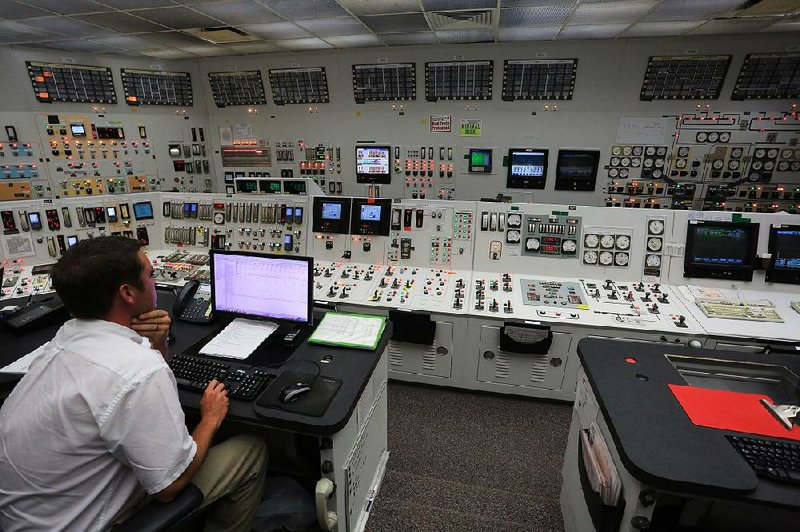RUSSELLVILLE -- An abundance of retirements at Arkansas Nuclear One contributed to the problems that caused a fatal 2013 industrial accident, executives with the federal Nuclear Regulatory Commission said Wednesday night.
Entergy Corp. made cutbacks across its fleet of nuclear power plants from 2007 through 2013 to try to remain competitive, said Neil O'Keefe, the commission's branch chief responsible for oversight of Arkansas Nuclear One.
"Starting in late 2012, Entergy also had an unexpected increase in retirements," O'Keefe told an audience of more than 100 meeting at a conference center near the plant.
Entergy turned over more than half of its engineers, O'Keefe said. That left inexperienced, newly hired engineers who had trouble with the plant's programs, O'Keefe said. Those programs normally were run by a few engineers.
"The amount of oversight and training to get those guys up to speed is pretty high," O'Keefe said.
Entergy Arkansas has struggled to recruit experienced workers to operate and maintain the plant's two nuclear reactors, O'Keefe said. Russellville is a place where employees enjoy their work and the area, O'Keefe said. But persuading experienced nuclear engineers to transfer to Russellville hasn't been easy.
For more than a year, Entergy has hired some of its retired engineers to return as consultants training some of the engineers at the plant, O'Keefe said.
"It is clear that our performance experienced subtle decline from 2007 to 2013," said Jeremy Browning, site vice president over the plant. "As a result of that subtle decline, self-revealing events occurred at this [plant], resulting in a need for the NRC to intervene."
Arkansas Nuclear One is one of only two nuclear power plants in the country carrying the Nuclear Regulatory Commission's column-four rating, meaning it receives the highest level of inspection oversight from the federal commission. The other plant is Pilgrim Nuclear Power Station in Plymouth, Mass., an Entergy facility scheduled to be shut down in the near future.
Nuclear power plants assigned a column-five rating, the worst, are prohibited from operating.
The Russellville plant was dropped from column one, the highest rating, to column four after the industrial accident in March 2013. The accident happened when a 1 million-pound generator stator was mishandled while being moved by a contractor, causing it to fall 30 feet. One worker was killed and eight others injured.
Commission representatives stressed that the nuclear plant is operating safely, even though it remains in column four.
After extensive evaluations by Entergy staff members, the company determined there had been a pattern of declining performance, O'Keefe said. In response, Entergy set up a recovery plan.
Browning said, "Our motivation to change is based on a core value that we will protect the health and safety of the public, which includes every employee that works here."
The federal commission had 17 experienced inspectors conduct more than 4,000 hours of inspections of the plant in January and February, roughly the number of inspections done for a year at a typical nuclear plant, O'Keefe said.
All of the inspection findings were of very low safety significance, said Victor Dricks, spokesman for the commission.
"[The inspections are] a multiyear effort," Dricks said. "We are about a year into it. We expect it will take at least another two years."
Some of the fundamental problems included leadership, organizational capacity, preventive maintenance, decision making and risk management, vendor oversight, nuclear fundamentals, training employees and safety culture.
These problems were among the causes of declining performance at the plant, the commission found. One of the causes of declining performance was staff turnover and the loss of experience by the turnover, O'Keefe said.
Leaders at the nuclear plant are committed to being their own worst critic, Browning said.
"Inward reflection starts with me," Browning said. "Through the inspection process, it became clear to me that I did not do my job to set the proper vision and direction for this [plant]."
Acknowledging the problems identified by the Nuclear Regulatory Commission was a fundamental shift for Entergy, said Marc Dapas, the agency's regional administrator.
"In the past, there would be deflection and denial in terms of whether problems truly exist," Dapas said to the Entergy representatives. "That represents a significant shift in culture. But actions speak louder than words. We will be anxious to see how effective you are in implementing those actions and sustaining those actions."
Entergy estimated in its recent annual report that the total cost of the damage done from the 2013 accident was about $95 million. Entergy has received about $50 million from its insurer in connection with the accident and is seeking additional recoveries under the policy. Entergy also has sued the contractors involved in the accident in Pope County Circuit Court seeking to collect damages.
Entergy Arkansas spent about $53 million last year to prepare for Nuclear Regulatory Commission inspections that began early this year, and expects to spend another $50 million this year for additional commission inspections, Entergy Corp. said in its annual report.
Business on 04/08/2016

